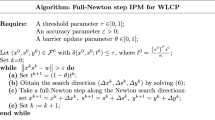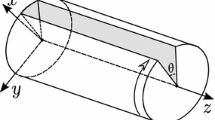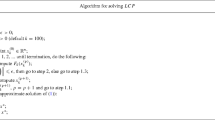Abstract
In this paper, we present a new interior point method with full Newton step for monotone linear complementarity problems. The specificity of our method is to compute the Newton step using a modified system similar to that introduced by Darvay in Stud Univ Babe-Bolyai Ser Inform 47:15–26, 2017. We prove that this new method possesses the best known upper bound complexity for these methods. Moreover, we extend results known in the literature since we consider a general family of smooth concave functions in the Newton system instead of the square root.
Similar content being viewed by others
References
Achache, M.: A weighted path-following method for the linear complementarity problem. Univ. Babes. Bolyai. Ser. Inform. 49(1), 61–73 (2004)
Achache, M.: A new primal-dual path-following method for convex quadratic programming. Comput. Appl. Math. 25(1), 97–110 (2006)
Achache, M.: Complexity analysis and numerical implementation of a short-step primal-dual algorithm for linear complementarity problems. Appl. Math. Comput. 216(7), 1889–1895 (2010)
Asadi, S., Mansouri, H.: Polynomial interior-point algorithm for \({P}_*(\kappa )\) horizontal linear complementarity problems. Numer. Algorithms 63(2), 385–398 (2013)
Asadi, S., Mansouri, H.: A new full-Newton step O(n) infeasible interior-point algorithm for \({P}_*(\kappa )\)-horizontal linear complementarity problems. Comput. Sci. J. Mold. 22(1), 37–61 (2014)
Asadi, S., Mansouri, H., Darvay, Z.S.: An infeasible interior-point method with improved centering steps for monotone linear complementarity problems. Asian-Eur. J. Math. 8(03), 1550037 (2015)
Asadi, S., Mansouri, H., Darvay, Z.S., Zangiabadi, M.: On the \(P_*(\kappa )\) horizontal linear complementarity problems over Cartesian product of symmetric cones. Optimiz. Methods Softw. 31(2), 233–257 (2016)
Asadi, S., Mansouri, H., Darvay, Z.S.: An infeasible full-Newton step interior point method for horizontal linear complementarity problem over Cartesian product of symmetric cones. Optimization 66(2), 225–250 (2017)
Asadi, S., Zangiabadi, M., Mansouri, H.: A corrector-predictor interior-point algorithm for \(P_*(\kappa )\)-HLCPs over Cartesian product of symmetric cones. Numer. Funct. Anal. Optimiz. 38(1), 20–38 (2017)
Darvay, Zs: A new algorithm for solving self-dual linear optimization problems. Stud. Univ. Babe-Bolyai Ser. Inform. 47, 15–26 (2002)
Darvay, Zs: New interior-point algorithms in linear programming. Adv. Model. Optimiz. 5(1), 51–92 (2003)
Facchinei, F., Pang, J.-S.: Finite-dimensional variational inequalities and complementarity problems. Springer, (2007)
Haddou, M., Maheux, P.: Smoothing methods for nonlinear complementarity problems. J. Optimiz. Theory Appl. (2014)
Illés, T., Roos, C., Terlaky, T.: Polynomial affine-scaling algorithms for \({P}_*(\kappa )\) linear complementary problems. In: Recent Advances in Optimization, pp. 119–137. Springer, (1997)
Kojima, M., Megiddo, N., Noma, T., Yoshise, A.: A unified approach to interior point algorithms for linear complementarity problems, vol. 538. Springer, (1991)
Migot, T., Haddou, M.: A smoothing method for sparse optimization over polyhedral sets. In Modelling, computation and optimization in information systems and management sciences, pp. 369–379. Springer, (2015)
Roos, C.: A full-Newton step O(n) infeasible interior-point algorithm for linear optimization. SIAM J. Optimiz. 16(4), 1110–1136 (2006)
Roos, C.: An improved and simplified full-Newton step O(n) infeasible interior-point method for linear optimization. SIAM J. Optimiz. 25(1), 102–114 (2015)
Roos, C., Terlaky, T., Vial, J.-Ph.: Interior point methods for linear optimization. Springer, (2006)
Wang, G.Q., Bai, Y.Q.: A new primal-dual path-following interior-point algorithm for semidefinite optimization. J. Math. Anal. Appl. 353(1), 339–349 (2009)
Wang, G.-Q., Bai, Y.-Q.: A primal-dual interior-point algorithm for second-order cone optimization with full Nesterov-Todd step. Appl. Math. Comput. 215(3), 1047–1061 (2009)
Wang, G.-Q., Bai, Y.-Q.: A new full Nesterov-Todd step primal-dual path-following interior-point algorithm for symmetric optimization. J. Optimiz. Theory Appl. 154(3), 966–985 (2012)
Wang, G.Q., Fan, X.J., Zhu, D.T., Wang, D.Z.: New complexity analysis of a full-Newton step feasible interior-point algorithm for \({P}_*(\kappa )\)-LCP. Optimiz. Lett. 9(6), 1105–1119 (2015)
Author information
Authors and Affiliations
Corresponding author
A Numerics
A Numerics
To validate the theoretical results, we first implemented the \(\varphi \)-FN-IPM described in Algorithm 2 with the sequence of update parameters given by Theorem 3.4 and with the functions \(\varphi \) given in Table 1.
The datasets and the residuals after convergence are detailed in Table 2. The stopping criterion is \(z^Ts \le n \epsilon \), where \(\epsilon =10^{-6}\), and we compute the residuals as \(\Vert zs\Vert _\infty \times 10^6\). For every \(\varphi \) function that appears in Table 1, the method converged in the same number of iterations, so we only display the number of iterations once. This phenomenon is not surprising, since the \(\varphi \)-FN-IPM used here stays very close to the central path, as shown by Theorem 3.3. Therefore, this implementation does not exploit fully the new directions. Nonetheless, some small differences remain in the residuals as illustrated in Table 2.
To illustrate the possible differences between the functions \(\varphi \), we run another experiment that considers a fixed value for \(\theta ^k=\frac{1}{\sqrt{n}}\) for all \(k \in \mathbb {N}\).
Table 3 illustrates the different behaviours observed for different choices of \(\varphi \). We notice that a smaller number of iterations seems to be required when the derivative in zero is larger for the methods with \(\alpha =0.25,0.5\) and 0.75. Thus, further research exploring interior-point methods in large neighbourhood of the central path may get the best out of these differences.
Rights and permissions
About this article
Cite this article
Haddou, M., Migot, T. & Omer, J. A generalized direction in interior point method for monotone linear complementarity problems. Optim Lett 13, 35–53 (2019). https://doi.org/10.1007/s11590-018-1241-2
Received:
Accepted:
Published:
Issue Date:
DOI: https://doi.org/10.1007/s11590-018-1241-2




